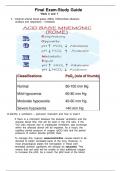Exam (elaborations)
NRNP 6566 WEEK 11 FINAL EXAM LATEST UPDATED COMPLETE SOLUTIONS GRADED A+ 2024
NRNP 6566 WEEK 11 FINAL EXAM LATEST UPDATE GRADED A+ 2024 NRNP 6566 WEEK 11 FINAL EXAM LATEST UPDATE WITH COMPLETE SOLUTIONS GRADED A+ NRNP 6566 WEEK 11 FINAL EXAM LATEST UPDATE WITH COMPLETE SOLUTIONS GRADED A+
[Show more]
Preview 4 out of 80 pages
Uploaded on
November 22, 2024
Number of pages
80
Written in
2024/2025
Type
Exam (elaborations)
Contains
Questions & answers
$17.99
100% satisfaction guarantee
Immediately available after payment
Both online and in PDF
No strings attached
Final ilExam-Study ilGuide




